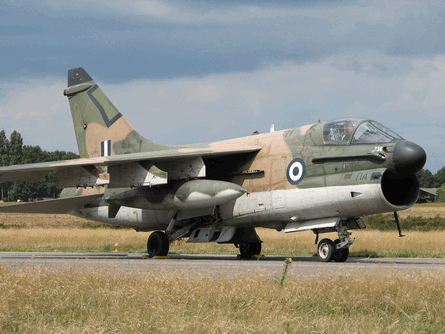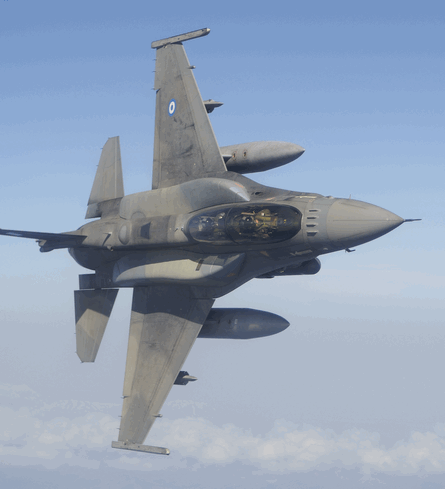Pressing domestic requirements for new-generation multirole fighters and advanced jet trainers will dominate the proceedings at the 15th tri-service Defendory show in Athens, Greece from 7-11 October. For the first time the biennial show will be held at the Hellenikon Exhibition Centre on the old Athens airport site this offers 20% more space than the previous event in 2006.
But, like last time, the Greek defence ministry's ability to procure new equipment will be hamstrung by the budget crisis that was caused by the nation's hosting of the Olympic Games in 2004.
The Greek air force urgently needs a new fighter to replace its Vought A-7 Corsairs and part of its inventory of McDonnell Douglas F-4 Phantoms. Early this decade Athens selected the Eurofighter Typhoon to meet its requirements with an unexpected bid to buy 60, with 30 options.
 |
|---|
© JMJMC. Oversteyns/Airspace |
A change of government and the financial fallout from the Athens Olympics put an end to that deal but fresh bids are likely to be sought late this year, say industry sources.
The Typhoon will again be a strong candidate, as it is already in service with the air forces of Austria, Germany, Italy, Spain and the UK, and is in production for Saudi Arabia. But it faces some stiff competition. Other anticipated contenders for the Greek programme include the Boeing F/A-18E/F Super Hornet, Dassault Rafale, Lockheed Martin F-16 and Saab Gripen.
It is not clear if Russia will attempt to compete for such a high-profile sale to a country that is also a NATO member, but if so its options would include variants of the RSK MiG-29 and Sukhoi Su-30.
The Greek air force currently has nearly 300 combat aircraft and deliveries of 20 new F-16C Block 52+ fighters and 10 D-model trainers will begin early next year. They were purchased through Athens' so-called Peace Xenia IV attrition buy, initiated with the US government in late 2005 and worth almost $2 billion. Deliveries will conclude in late 2009 - these aircraft join more than 130 F-16s already in Greek service.
 |
|---|
© Katsuhiko Tokunaga/Lockheed Martin |
Towards the end of last year Dassault delivered the last of 15 Mirage 2000-5 fighters to Tanagra air base. These are capable of carrying MBDA Storm Shadow cruise missiles that have a range of more than 250km (135nm) they join almost 30 Mirage 2000BG/EGs acquired through previous purchases.
Dassault hopes that its partnership with Snecma and Thales, as well as local participation offered to companies including Hellenic Aerospace Industry, will lead to a successful Rafale campaign.
Looking to its longer-term requirements, Greece is not involved in the Lockheed F-35 Joint Strike Fighter programme, unlike its NATO ally but traditional rival Turkey.
But the Greek government and HAI are involved in Europe's Dassault-led Neuron unmanned combat air vehicle demonstrator project, which is expected to fly for the first time in 2011.
A new-generation advanced jet trainer is also a top air force priority, with the service continuing to operate an aged fleet of more than 40 Rockwell T-2 Buckeyes: a model whose heritage dates to the 1950s.
Finally retired from service by the US Navy earlier this year, the T-2 is becoming increasingly difficult and expensive to support, but more vitally it presents a major training gap when preparing pilots to fly the F-16 and Mirage 2000.
Two years ago the Defendory show attracted a marketing push from several AJT manufacturers, offering the Aero Vodochody L-159BAT, Alenia Aermacchi M-346, BAE Systems Hawk and Korea Aerospace Industries/Lockheed T-50.
Boeing also promoted the Hawk-derived T-45 Goshawk, but signed a recent deal to market the M-346. "Boeing is examining options that include the T-45 and an expanded relationship with Alenia Aermacchi," the company says. But it adds: "Until we have a better understanding of the Hellenic air force's requirements and timeline, it is premature to rule out alternatives."
Greece is a signatory to the slow-moving Advanced European Jet Pilot Training, or Eurotraining scheme, but the urgent nature of its requirement means it is unlikely to be able to wait. According to figures released by the AEJPT steering committee earlier this year, the Greek air force's requirement calls for the training of 58 student pilots a year, with an initial operational capability sought during 2010 - five years before the multinational system is expected to reach the same milestone.
But with HAI having signed a previous agreement with Alenia Aermacchi based on offering the M-346 - the favoured AJT for the Eurotraining initiative - and two Greek air bases being among the list of sites considered to host part of the multinational infrastructure, a further delay might be politically acceptable to Athens.
The Greek air force has already acquired a modern primary trainer, with its students having access to 45 Beechcraft T-6As. It also sends students to the Euro-NATO Joint Jet Pilot Training programme in the USA.
In the transport sector, Greece has now taken delivery of eight of its 12 Alenia Aeronautica C-27J Spartans, for which it was the launch export customer. Its air force's legacy fleet of Lockheed C-130B/Hs is currently being upgraded, and it is not involved in Europe's replacement Airbus Military A400M programme.
Athens has previously acquired four Embraer EMB-145 regional airliners modified to carry the Saab Microwave Systems Erieye airborne early warning and control radar, and the last of these systems was due for delivery in late September. The surveillance aircraft are operated from Elefsis air base, and have already completed final acceptance tests with the Greek customer. Elsewhere in the surveillance field, the air force has a long-term requirement to replace its aged fleet of Lockheed P-3B Orion maritime patrol aircraft.
Greek army procurement includes a current order for 20 NH Industries NH90 tactical transport helicopters, including four configured to support missions involving special operations forces. The pending delivery of a final four Boeing AH-64D attack helicopters will swell the service's inventory of A- and D-model Apaches to 32 aircraft.
First staged in 1980, the Defendory show is expected to attract at least 500 exhibitors from around 35 nations this year, and its organisers expect 80,000 people to attend the show, which is not open to the public. The biennial event looks to have an bright future, with dates having been confirmed out to 2020.
Source: Flight International























